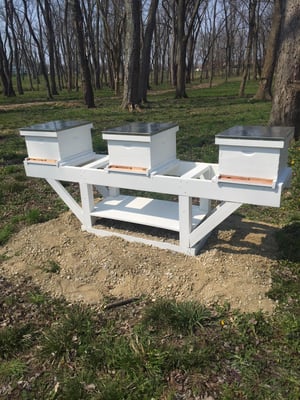 When you think of bee boxes, planting clover and wildflowers, SugarCreek may not be the first thing that comes to mind. As a food manufacturing company, our priorities are health, safety, and .. well .. makin’ bacon, right? Right: making a quality product for our customers is our number one priority, but the reality is that SugarCreek would not be able to do what we do without bees. So, to say the least, we owe them a lot.
When you think of bee boxes, planting clover and wildflowers, SugarCreek may not be the first thing that comes to mind. As a food manufacturing company, our priorities are health, safety, and .. well .. makin’ bacon, right? Right: making a quality product for our customers is our number one priority, but the reality is that SugarCreek would not be able to do what we do without bees. So, to say the least, we owe them a lot.
Unfortunately, business is not “as usual” in the bee world. Bees, the world’s greatest pollinators, are irreplaceable actors in our ecosystem but are quickly losing their habitats and declining in population. According to the Natural Resources Defense Council, more than 25% of the honey bee population has disappeared since 1990. In 2017, the Rusty Patched Bumble Bee was listed as an endangered species. The bottom line is that while bees may be small, their jobs as pollinators play a huge role in the production of the food that we eat. Their disappearance could prove catastrophic. According to the FDA, about one-third of food eaten by Americans comes from crops pollinated by honey bees. Not only do bees provide food security for us humans, but they also play a key role in the production of clover, legumes, and alfalfa, all ingredients which are essential to producing pork and poultry feed. So, let’s put it plainly: we want to keep making bacon and you want to keep eating it, all while making the world a better place for our bees. So as part of SugarCreek’s efforts to be more sustainable, socially responsible, and to continue to be a leader in the food industry, we are beginning a journey into the world of bee keeping, and are building hives of our own in order to combat habitat loss and the ever-shrinking bee population.
Heading the project are SugarCreek employees and self-taught bee experts Pete Motza and Andy Bamforth. Motza first became interested in bees when a swarm unexpectedly set up camp in a tree in his yard. Looking for a hobby and intrigued by the bees’ sudden appearance, he began researching. Bamforth has been a beekeeper for several years and received his first hive as a father’s day gift. After joining the company last year, he was tasked with incorporating hives into the green space by senior management. Motza and Bamforth chose a field to the West of Sugar Creek’s Dayton plant as the first hive’s location. It is an ideal habitat for the bees: full of white clover, purple nettle, and dandelions. Earth day marks the project’s first benchmark: the hives have been constructed, painted, placed in the field, and are now ready for the queens to arrive!
Join SugarCreek in becoming part of the solution. If you’re looking to find a way to increase your local bee population, plant flowers in your garden that are native to your area. If you don’t have a yard or live in an apartment, planting flowers in some pots outside is a great alternative, as every flower makes a difference! Buying honey from your local beekeeper is also a great way to support local bee populations.
Beekeeping at SugarCreek will be a continuing journey -- check back regularly to learn the latest!
Questions or comments about the article or project? Contact Andy Bamforth at ABamforth@sugar-creek.com, Pete Motza at PMotza@sugar-creek.com, or ENorbut@sugar-creek.com





